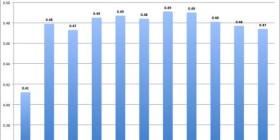If you pay attention to what the various players in tech are reading, you may have seen some of them talking about the book The Accidental Superpower. I heard about the book from Mark Suster and shortly after reading it myself, saw Auren Hoffman posting about it. If you haven’t read it, it generally ignores the common discussions of education, computer technology, and partisan political dysfunction as they relate to the future and looks at the world we will soon face based on broad geopolitical and demographic shifts.
One of the things the author, Peter Zeihan, explains is how the size of the Baby Boomer generation has provided a flood of capital into the global economy, and as they retire and begin to draw money out of the system, capital will become much more scarce. In short, we are at the tail end of a large (Boomer) working and investing population that is about to be replaced by a much smaller (Generation X) working and investing population, and that shift will result in a global capital crunch.
If he’s right, then venture capital as we know it is about to be a thing of the past. As the massive pool of global investment capital dwindles, venture capital as an industry will also shrink as firms find it much harder to raise funds. When the belt-tightening trickles down through the entire ecosystem, what does the rest of Silicon Valley look like without all the easy money sloshing around? Can the Valley even survive? Let’s consider what a cash-starved Silicon Valley might look like.
Angel Investors. True angels invest with their own money and don’t raise outside funds. Assuming their broad investment portfolios don’t collapse, they should be less affected than the rest of the investment chain because they’re not relying on limited partners, retirement funds such as CalPERS, and Wall Street money. However, angels rely on VCs to take their seed and early investments to the next level. If VCs don’t have the money to fund the next rounds, angels can’t survive.
Second-Tier VCs. Second-tier firms are probably screwed. If global investment dollars are tight, these firms will likely be some of the first players to feel the squeeze. Once they exhaust the funds they’ve already raised, expect many to disappear. If you think the series A crunch is bad now, wait until this entire segment of venture capital goes away.
Large First-Tier VC Funds. Venture capital as an industry won’t disappear completely; expect the blue chip players to continue. Their overall fund sizes might be smaller, though, and expect them to play a little more cautiously. With fewer second-tier firms left to join a funding round, overall dollars invested in companies will decrease even if the first-tier firms stay in business with large funds.
Now let’s think about what this means for the broader ecosystem of Silicon Valley:
Less investment money means fewer startups. Unless tech entrepreneurs figure out how to bootstrap their way to success, this is simple math.
Fewer funded companies means fewer jobs.
Surviving venture capital firms will likely expect profitability to come sooner and be less willing to wait for a liquidity event. This means smaller and shorter term bets.
Unlike other parts of the country whose various industries are largely self-sustaining based on actual profit, much of Silicon Valley is artificially supported by venture capital money. When that money goes away, as it did in 2000-2001, the entire region collapses almost overnight.
If Zeihan’s predictions about demographics and its effect on the global capital supply are correct, then unlike after the first dot-com collapse, the VC industry will not rebound in a few short years, and by extension, the vibrant economy we have come to expect in Silicon Valley will cease to exist.
I don’t know for sure if any of this will happen, I’m only making my best-guess extrapolations of how the Valley will be affected based on the broader predictions put forth by the author. But the effects of changing demographics on an economy have proven to be a prescient predictor. If you’re old enough to remember Japan’s towering success in the late 1980s followed by over two decades of continuing stagnation, then you’ve seen the havoc an aging demographic can wreak on an economy.
If Peter Zeihan is right and capital becomes scarce, the Silicon Valley of today may well prove to be analogous to the Japan of the ’80s, and we are about to go into a long and painful period of decline.






Leave a reply